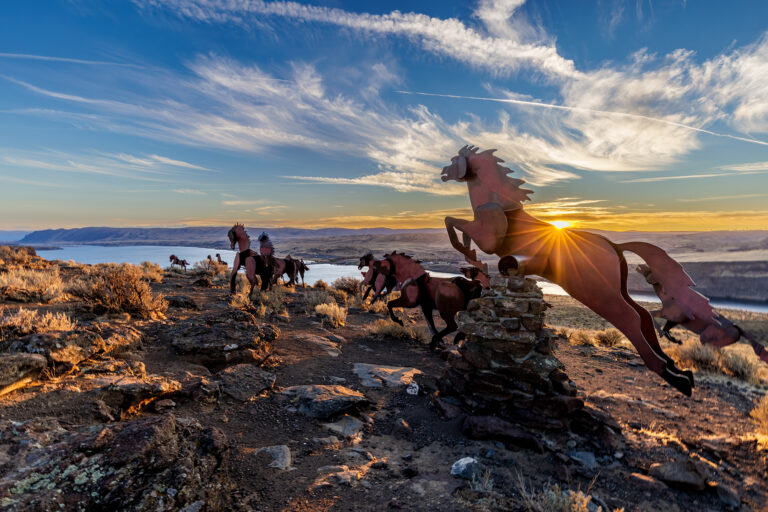Spokane is very fortunate to have a great multi-use trail like Centennial Trail running through our city. Probably the busiest section of the Centennial Trail is the piece that runs from Riverfront Park to Mission Park. This section passes by downtown, the University District, multiple hotel sites, the convention center, two parks, multi-family housing, and multiple businesses. In short, this is a very urban section of trail used by many people every day as part of their exercise or commuting routine. Add to this user base many out-of-town visitors, drawn by Riverfront Park, or conventioneers on a stroll in between sessions.
On a sunny afternoon, this urban section of trail is as busy as any multi-use trail in much bigger cities. And like all multi-use trails, there are no rules.
Well, strictly speaking, there are rules, but practically speaking, very few people know them, and even fewer people follow them. When it comes to bikes and pedestrians sharing space, the rules are always the same: cyclists yield to pedestrians. Always.
A tragic reminder of this simple rule was illustrated last month on the Cedar River Trail in Renton. An 83-year-old woman was killed when she was struck and knocked down by a cyclist. This is an awful way to make a point, but if you ride through congested sections of multi-use trails often, then you can see how this sort of accident could happen.
So the always yield to pedestriansî rule is the law of the land, but for all multi-use trail users it’s really best to focus on common sense, etiquette, and courtesy.
Let’s start with the cyclists:
The multi-use trail speed limit is officially 15 miles an hour. Fifteen miles an hour works great on the long stretches of the Centennial Trail outside the city. But for the urban section, I’m guessing 7 miles an hour should be tops.
Which brings up the commuting point: If you are looking to make fast time through the city core, the Centennial Trail is not the place to do it. Streets with stop lights are timed to optimize traffic flow. In addition, unlike the multi-use trails, the rules of the road are well understood. And tri trainers: the downtown section of the Centennial Trail is not the place to perfect your aero tuck for time trailing.
When passing, use a bell, or use your voice: don’t be a Ninja. This is a really hard one if you don’t want to be screaming at everyone, but if you are going to pass, be sure to provide a warning. In my experience, saying on your left,î results in the person you are passing to immediately drift left, so I like to say, Passing,î or better, Good morning!î The best solution: a bell.
Watch that blind 90 degree corner by the tall Balazs piece at the northwest of the Opera House. If you’re heading into the park at that corner, hug the wall and come to a near stop before taking the turn. If you’re going away from the park on that corner, take it really wide and really slow. If we have a Cedar Riverî incident on the Centennial Trail, I think this will be the place.
General etiquette reminder: People are strolling and enjoying being on the river and taking a walk outside. They are often chatting with friends or looking at views. They will walk in the middle of the trail and they will not expect any sort of traffic. Be patient.
For the pedestrians:
If you are walking with friends, try to remember to keep a laneî free as you walk down the trail abreast. The trail is a minimum of 10 feet wide. In many sections it’s wider. If you can remember to leave a lane open, then you’ll get smiles from cyclists and things will move nicely.
Dogs are great. Your dog is the greatest. And those 30-feet, mostly-invisible leashes are sweet when you are in the middle of a park. But on trail, please keep the dog closer to your side. As I approach you walking on the right side of the trail, but see a dog 20 feet away on the left side of the trail, it’s not intuitive that the dog is hooked to you, especially since I can’t see that tiny thread of a leash.
And people with a dog trotting around not on a leash? Are you serious?
If you are a pedestrian hooked into roller blades and an iPod, I understand that swinging your arms from side-to-side helps with the momentum, but if you could just move over a bit, I could squeeze by when you swing right.
You shouldn’t have to really think about being in traffic when you take a walk on the trail along the river. But a lot of cyclists and runners use the trail as their daily route. Please take a quick over-the-shoulder glance before changing direction suddenly. Bikes are mostly silent, so you’re not likely to hear them coming up behind you. But they often are coming up and they are expecting you to hold your line,î so a quick change of direction can be surprising.
John Speare grew up and lives in Spokane. He rides his bike everywhere. Check out his blog at http://cyclingspokane.blogspot.com.













